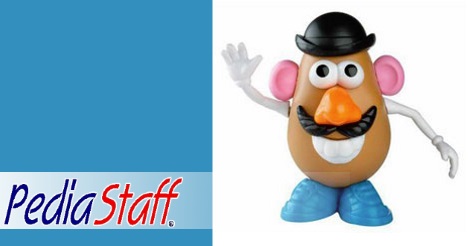Speech Therapy at Home! Mr. Potato Head
Editor’s Note: In addition to Shareka’s GREAT ideas featured here, check out this second blog post on our dear friend Mr. Potato head by Allison Fors
Don’t have Mr. Potato Head, or is he missing pieces? Buy him or her through our affliate link on Amazon

Copyright 2010, Shareka Bentham, SLT.
This blog post has been reprinted with express permission of the author as it appeared on her blog Easy Speech and Language Ideas
He may seem like just an ordinary guy but Mr. Potato Head has a secret. He is the life of the party in so many clinics, homes and schools around the world. He has proven to be extremely useful so far as a valuable resource for speech and language intervention. Therefore he gains the title of “Resource of the Week!” I thought I’d share with you readers 4 different ways in which I used good old Mr. PH today in my therapy sessions.
Case 1: child with autism, teaching imitation skills as well as building vocab for body parts and clothing.
It’s good to have more than one Mr. Potato Head with matching items so you can do this type of activity. I put each part on while naming it, and he was required to choose the item from his pile and copy me. (saying the part on imitation was a bonus, which he achieved a few times). This also required lots of active looking to achieve. He required prompting by dad for the first 2 or so but he quickly caught on and the activity went well 🙂
Case 2: child with cochlear implant, in aural rehab session
I’ve used Mr. PH with him in earlier sessions for his conditioned response to Ling sounds, however this week was to listen for body parts. I got him to search for the body part when said, then when he found it match it to his own body part. I also provided lots of auditory input for “sh”, saying pushhhhhhh whenever he was fitting an item.
Case 3: Child with language delay, working on following directions
I saw my supervisor do this once and fell in love with the activity. This was somewhat a test of all of the concepts we had learnt over the past few weeks in therapy. Activity involved:
- Following 2 step directions: first put his eyes on, then one ear
- Directions with before and after: after you put on an ear, put on his hat
- Either….or constructions: put on either his teeth or his nose
- Negation: which hand is not on?
I must say he worked so well on this task. I’ve had trouble before, finding ways to target these specific areas, so good job Potato dude!
Case 4: child with weak Phonological Awareness skills: Rhyming task
Now this was a fun way to end the day, trying to find all of Mr. PH’s body parts, clothing items that rhymed. It went a bit like this :
- Say hose, now find his……..(nose)
- Say pat, now find his…..(hat) etc.
Then I turned it around and let him tell me the rhyming word so I could find the body parts etc. This was a bit more difficult for him but with lots of prompting he got through it.
Great sessions all around.
And that my friends is how Mr. Potato Head saved the day! Art Therapy has unique qualities that help the child with Autism. Many children with Autism tend to be visual learners and traditional methods of instruction can often be quite challenging. Therefore, visual art directives and projects are a great way to help children with Autism learn and communicate, as well as interact and function in the world.
Featured Author: Shareka Bentham, SLT
From her blog: My name is Shareka Bentham, I’m a Speech and Language therapist (also known as a Speech Pathologist in some countries), working in private practice. I earned my Masters in New Zealand and returned to Barbados to practice. I’m quite a newbie in the field, as this is my first year practising, but I’ve learnt a lot thus far. There aren’t many speech therapists in my country, one working in government, and the remaining 4 or so in private practice catering to a population of approximately 275,000. Needless to say I have a pretty hectic caseload with a range of communicative needs. I work with both paediatric and adult populations with speech, language, social communication voice, fluency, and feeding disorders and my settings range from clinic, hospitals, and house/school visits. I’m also the in-house therapist at one primary school, so yes it gets quite busy.
PediaStaff is Hiring!
All JobsPediaStaff hires pediatric and school-based professionals nationwide for contract assignments of 2 to 12 months. We also help clinics, hospitals, schools, and home health agencies to find and hire these professionals directly. We work with Speech-Language Pathologists, Occupational and Physical Therapists, School Psychologists, and others in pediatric therapy and education.
